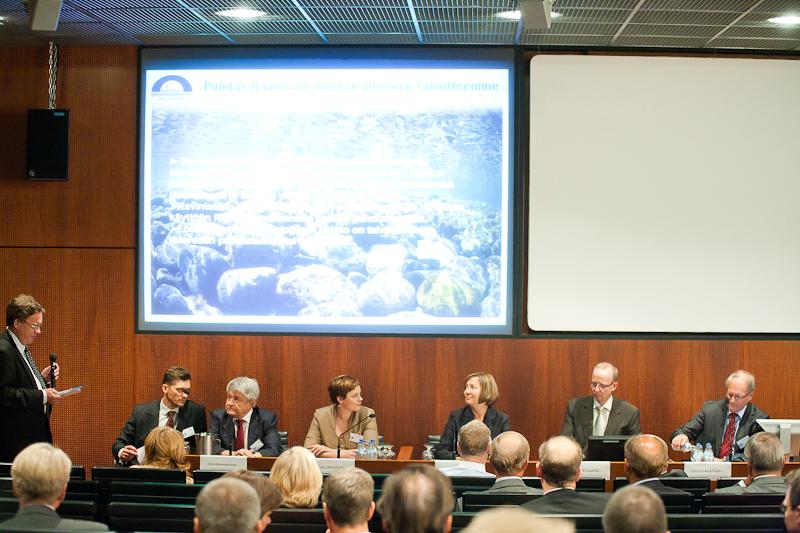Warning: Undefined array key "file" in /data/wordpress/htdocs/wordpress/wp-includes/media.php on line 1676
Club Itämeri, the John Nurminen Foundation’s first stakeholder meeting held on 26 August in the Sanomatalo, attracted about 100 supporters and stakeholders of the Foundation’s Clean Baltic Sea project. The meeting was opened by Jaakko Rauramo, Chairman of the Board of Directors of Sanoma Oyj and host of the event. Other speakers at the meeting included Paula Lehtomäki, Minister of the Environment; Felix Karmazinov, General Director of the waterworks of St. Petersburg; and Juha Nurminen, Chairman of the Board of the John Nurminen Foundation.
Nothing is impossible – praise for the achievements in St. Petersburg
In his address, Mr Rauramo explained Sanoma Corporation’s reasons for supporting the Foundation: “There’s no point in us torturing ourselves with climate issues that we can’t do anything about.But we can do something about the discharge of phosphorus in the Baltic Sea,” he said. Last April, the John Nurminen Foundation and Sanoma signed a three-year cooperation agreement. This cooperation gives the John Nurminen Foundation visibility in Sanoma’s various media for its fundraising campaign launched in June with the slogan “Nothing is impossible”. The campaign is prominent on the Foundation’s website and was first displayed in Sanoma’s media in July.
Juha Nurminen gave an update on the progress of the Foundation’s projects and reminded those present of the scope of the St. Petersburg project. By the end of the year, the wastewater treatment in St. Petersburg will have been able to reduce the discharge of phosphorus by 1,000 tons, which is almost 30% of the total amount of phosphorus ending up in the Gulf of Finland. He also noted that discussion has started to focus more on wastewater from leisure boats, equalling about 6 tons, than about urban wastewater. Mr Nurminen was pleased with the media coverage and political attention given to the Baltic Sea but called for actions instead of words. ”It is a fact that the EU directive on urban waste water treatment still doesn’t require the level of phosphorus removal that the Baltic Sea needs.It is also a fact that, under the currently strained economic situation, HELCOM’s recommendations threaten to remain just recommendations.”
Mr Karmazinov told the audience that this year, 92% of the wastewater of St Petersburg will be treated and that the figure will be 95% by the end of 2011. “Now we dare to look the inhabitants of Helsinki in the eye, because we no longer pollute the Gulf of Finland,” he said. He spoke openly about the change in his own attitude – and about the psychological change that he through his personal commitment has brought about in St. Petersburg. “Initially, I was opposed to the project because we in St. Petersburg, as in Russia in general, believed that the wastewater was diluted by the Neva river. I am happy and grateful that my Finnish friends could make me change my mind.”
In her address, Minister of the Environment Paula Lehtomäki agreed that the John Nurminen Foundation’s efforts are focused on the right target: “Quite clearly, chemical phosphorus removal is the most cost-effective way to diminish the amount of cyanobacteria in the open part of the Gulf of Finland.”
Themes for the panel: agriculture and political will
After Mr Karmazinov’s address, the discussion continued in a panel debate chaired by Kari Huhta, foreign and security affairs editor at Finland’s largest newspaper Helsingin Sanomat. The other members of the panel were Minister Lehtomäki; Marjukka Porvari, director of John Nurminen Foundation’s eutrophication-related projects; Seppo Knuuttila, a researcher from the Finnish Environment Institute; and Johnny Åkerholm, President and CEO of the Nordic Investment Bank.
Huhta asked the panel members what makes protecting the Baltic Sea so difficult – why is it not getting cleaned up faster? There was no clear answer to the question. According to Ms. Lehtomäki, one reason is that there is still no single body responsible for the Baltic Sea. Although protecting the environment is important, Baltic Sea states have a number of other economic and social priorities.
A particularly sensitive issue in the debate is agriculture. For example, the John Nurminen Foundation has no current projects relating to dealing with the nutrient load from agriculture. According to Marjukka Porvari, achieving significant cuts in agricultural emissions requires political will and extremely radical decisions concerning issues where the Foundation has no authority. Such decisions relate to, for example, completely stopping with agriculture in certain areas. Ms. Porvari also called attention to the poor capacity of nitrogen removal in the Finnish wastewater plants; while Finnish municipalities they have been treating wastewaters for phosphorus in an exemplary manner for decades, many lag far behind the results in St. Petersburg. “In this respect we could learn a thing or two from St. Petersburg,” Ms. Porvari said.
Seppo Knuuttila also called for tough political decisions to be made. He too emphasised the significance of phosphorus removal for the health of the Gulf of Finland and for counteracting eutrophication. “The phosphorus load of St. Petersburg is expected to be reduced by a total of nearly 20,000 tons by 2020. This roughly equals about the phosphorus accumulated in the water volume of the Gulf of Finland today”, Mr Knuuttila said. Such a decrease would have a notable impact on the algae bloom in the summer.

